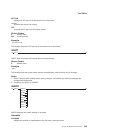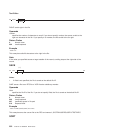
Chapter 19. REXX/CICS File System
The REXX File System (RFS) is provided for the storage of text files and execs created with the
REXX/CICS editor, and by execs using RFS commands and data imported from outside of the REXX File
System. RFS was modeled after the Advanced Interactive Executive (AIX) and OS/2 file systems. The
concept of directories is the main idea taken from these environments. Partitioning each directory into
several subdirectories will give a hierarchical organization.
You can access RFS functions by using the RFS command. In addition to providing the ability to perform
file I/O, the RFS command provides you the ability to do essential file system maintenance.
A file list utility (FLST) is provided as a full screen interface to the REXX File System. This utility can also
be used as a platform where other CICS work can be performed.
File Pools, Directories, and Files
File pools are sets of VSAM files. The first VSAM file in the pool contains information about the pool and
must be formatted before data can be written to the pool. All other VSAM files in the pool are extensions
of the first file and only need to be defined in the pool's list of VSAM files after they have been allocated
and defined to Access Method Services and CICS. VSAM files can be added to a file pool, at will, to
provide additional storage space in that pool. However, defining and adding space to file pools is a task for
REXX/CICS administrators or CICS Systems Programmers. File pools are given a unique one to seven
character name.
In each file pool, there is a root directory. The root directory for a file pool is named file_pool_name:\. This
directory can contain files as well as subdirectories. A subdirectory is a directory within another directory.
Subdirectories can be created within any other directory. A new directory can be created with the RFS
MKDIR command. All directories, except the root, are distinguished by a one to eight character directory
file name joined, by a period, with an optional one to eight character directory file type. This is called the
directory ID.
A file pool may be defined to be a user or non-user file pool. One directory that should exist in all user file
pools is the USERS directory. This directory contains several subdirectories that correspond to the users
on the system. When you save a file into the RFS for the first time, a new subdirectory is created in the
USERS directory. This new directory is named with your user ID if you are signed onto CICS. Otherwise,
the directory name will default to the CICS DFLTUSER value. After this directory is created, you can
create any number of subdirectories within that personal directory. You can place files in any of the
directories that you create.
Files are either data files or REXX execs. They use the same naming conventions as directories (a file
name and an optional file type joined with a period). The default file type for REXX execs is EXEC. Files
are created with the REXX/CICS editor or with the RFS DISKW command.
A fully qualified file ID consists of a file pool name followed by a :\, each directory's ID in the path followed
by a \, and the file ID, that is comprised of a file name and an optional file type.
The following example shows a fully qualified file ID. POOL1 is the file pool name, USERS and USER1
are directory ID's, and TEST.EXEC is the file ID.
Example:
POOL1:\USERS\USER1\TEST.EXEC
The following example shows file pools, directories, and files.
© Copyright IBM Corp. 1992, 2009 257


















